#November 1936
Text

A New York Central Mercury train is dwarfed by Cleveland’s Union Station, November 1936.Photograph by J. Baylor Roberts
#train#New York Central Mercury train#Cleveland’s Union Station#November 1936#1936#photography#black and white#art deco#Cleveland#30s#old photo
282 notes
·
View notes
Text

Film Fun - November 1936
Cover by Enoch Bolles
54 notes
·
View notes
Text










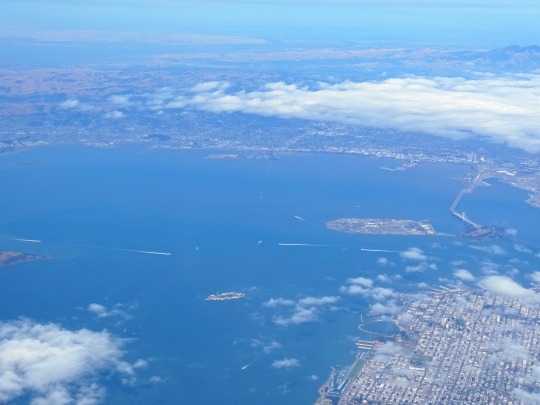


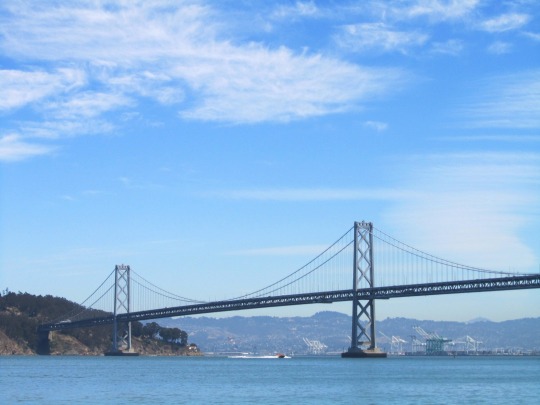
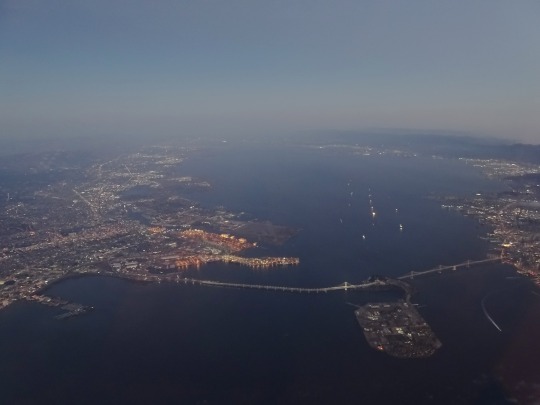
The San Francisco–Oakland Bay Bridge opened to traffic on November 12, 1936.
#San Francisco–Oakland Bay Bridge#opened#12 November 1936#US history#anniversary#San Francisco#San Francisco Bay#original photography#Charles H. Purcell#street scene#engineering#architecture#cityscape#landmark#tourist attraction#I-80#Interstate 80#summer 2012#2008#2019#summer fog#Alcatraz Federal Penitentiary#United States Penitentiary Alcatraz Island#summer 2017#travel#vacation#USA#California#2023#2022
18 notes
·
View notes
Text

Cruisers at Mare Island Navy Yard, Vallejo, California, circa November 3-5, 1936.
"USS Tuscaloosa (CA-37) left and USS Chicago (CA-29) right, alongside a dock, undergoing refit. Note numbers on turret roofs. USS Houston (CA-30) is ahead of Chicago."
NHHC: NH 84772
#USS Tuscaloosa (CA-37)#USS Tuscaloosa#New Orleans Class#USS Chicago (CA-29)#USS Chicago#USS Houston (CA-30)#USS Houston#Northampton Class#Cruiser#Mare Island Navy Yard#Vallejo#California#west coast#November#1936#interwar period#united states navy#us navy#navy#usn#u.s. navy#my post
53 notes
·
View notes
Text

Members of the starting lineup of the New York Giants pose for a photograph, November 19, 1936. The Giants were preparing for their game against the Green Bay Packers on November 22. From left to right, front row are: Tod Goodwin, Len Grant, Gaines Davis, Johnny Dell Isola, Mel Hein, Bill Morgan, and Buster Mitchell. Standing are: Tilly Manton, Dale Burnett, Ed Danowski, and Tuffy Leemans.
Photo: Associated Press
#New York#NYC#vintage New York#1936#football Giants#NY Giants football#football#November 19#Nov. 19#American football
18 notes
·
View notes
Text
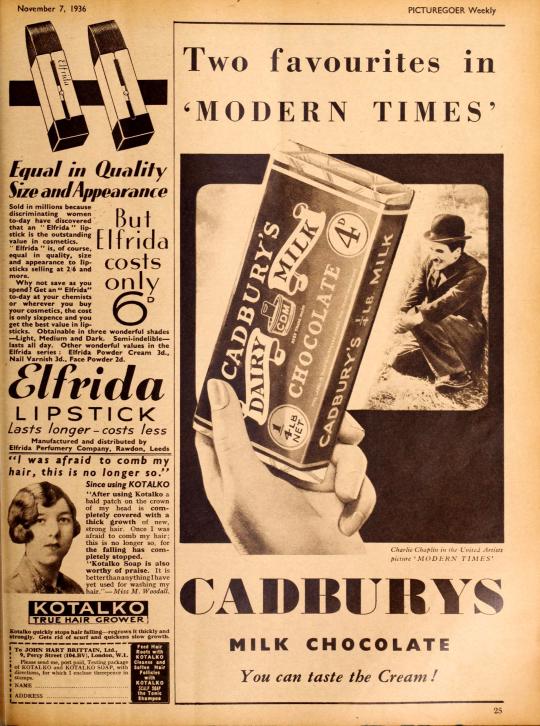
Cadbury chocolate ad featuring "Modern Times" in British magazine Picturegoer Weekly, November 1936.
13 notes
·
View notes
Text

The Bystander, England, November 20, 1936
5K notes
·
View notes
Text
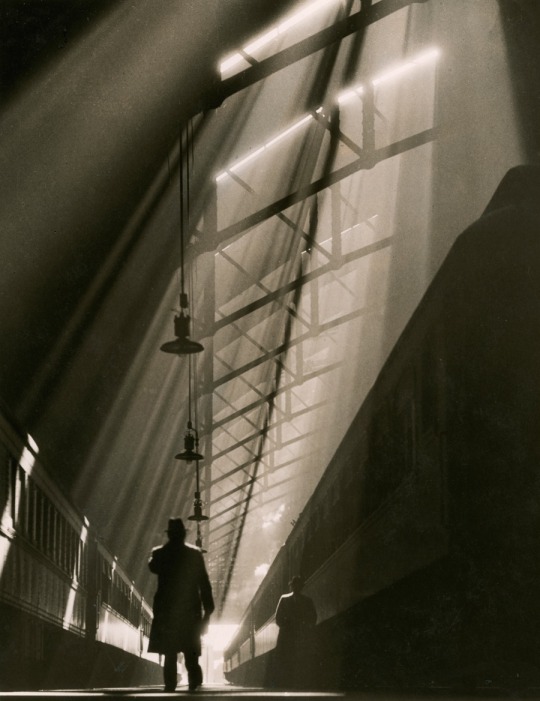
William M. Rittase. A view of Chicago’s historic La Salle Street train station, November 1936
#william m. rittase#vintage#photography#black and white#street photography#art#history#vintage photography#black and white photography#usa#ee.uu#1930s
1K notes
·
View notes
Text
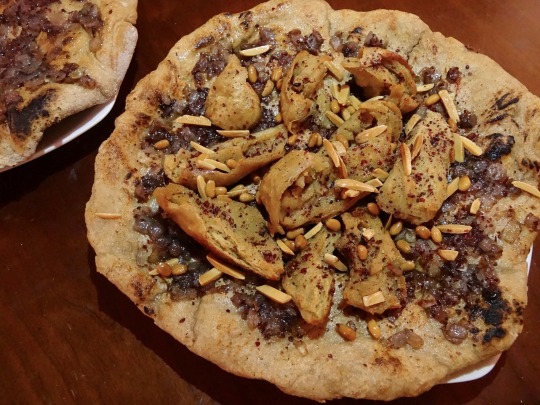

[ID: Two large flatbreads. The one in the center is topped with bright purple onions, faux chicken, fried nuts, and coarse red sumac; the one at the side is topped with onions and sumac. Second image is a close-up. End ID]
مسخن / Musakhkhan (Palestinian flatbread with onions and sumac)
Musakhkhan (مُسَخَّن; also "musakhan" or "moussakhan") is a dish historically made by Palestinian farmers during the olive harvest season of October and November: naturally leavened flatbread is cooked in clay ovens, dipped in plenty of freshly pressed olive oil, and then covered with oily, richly caramelized onions fragrant with sumac. Modern versions of the dish add spiced, boiled and baked chicken along with toasted or fried pine nuts and almonds. It is eaten with the hands, and sometimes served alongside a soup made from the stock produced by boiling the chicken. The name of the dish literally means "heated," from سَخَّنَ "sakhkhana" "to heat" + the participle prefix مُـ "mu".
I have provided instructions for including 'chicken,' but I don't think the dish suffers from its lack: the rich, slightly sour fermented wheat bread, the deep sweetness of the caramelised onions, and the true, clean, bright expressions of olive oil and sumac make this dish a must-try even in its original, plainer form.
Musakhkhan is often considered to be the national dish of Palestine. Like foods such as za'tar, hummus, tahina, and frika, it is significant for its historical and emotional associations, and for the way it links people, place, identity, and memory; it is also understood to be symbolic of a deeply rooted connection to the land, and thus of liberation struggle. The dish is liberally covered with the fruit of Palestinian lands in the form of onions, olive oil, and sumac (the dried and ground berries of a wild-growing bush).
The symbolic resonance of olive oil may be imputed to its history in the area. In historical Palestine (before the British Mandate period), agriculture and income from agricultural exports made up the bulk of the economy. Under مُشَاعْ (mushā', "common"; also transliterated "musha'a") systems of land tenure, communally owned plots of land were divided into parcels which were rotated between members of large kinship groups (rather than one parcel belonging to a private owner and their descendants into perpetuity). Olive trees were grown over much of the land, including on terraced hills, and their oil was used for culinary purposes and to make soap; excess was exported. In the early 1920s, Palestinian farmers produced 5,000 tons of olive oil a year, making an average of 342,000 PL (Palestinian pounds, equivalent to pounds sterling) from exports to Egypt alone.
During the British Mandate period (from 1917 to 1948, when Britain was given the administration of Palestine by the League of Nations after World War 1), acres of densely populated and cultivated land were expropriated from Palestinians through legal strongarming of and direct violence against, including killing of, فَلّاَحين (fallahin, peasants; singular "فَلَّاح" "fallah") by British troops. This continued a campaign of dispossession that had begun in the late 19th century.
By 1941, an estimated 119,000 peasants had been dispossessed of land (30% of all Palestinian families involved in agriculture); many of them had moved to other areas, while those who stayed were largely destitute. The agriculturally rich Nablus area (north of Jerusalem), for example, was largely empty by 1934: Haaretz reported that it was "no longer the town of gold [i.e., oranges], neither is it the town of trade [i.e., olive oil]. Nablus rather has become the town of empty houses, of darkness and of misery". Farmers led rebellions against this expropriation in 1929, 1933, and 1936-9, which were brutually repressed by the British military.
Despite the number of farmers who had been displaced from their land by European Jewish private owners and cooperatives (which owned 24.5% of all cultivated land in Palestine by 1941), the amount of olives produced by Palestinians increased from 34,000 tons in 1931 to 78,300 in 1945, evidencing an investment in and expansion of agriculture by indigenous inhabitants. Thus it does not seem likely that vast swathes of land were "waste land," or that the musha' system did not allow for "development"!
Imprecations against the musha' system were nevertheless used as justification to force Palestinians from their land. After various Zionist organizations and militant groups succeeded in pushing Britain out of Palestine in 1948—clearing the way for hundreds of thousands of Palestinians to be dispossessed or killed during the Nakba—the Israeli parliament began constructing a framework to render their expropriation of land legal; the Cultivation of Waste Lands Law of 1949, for example, allowed the requisition of uncultivated land, while the Absentees’ Property Law of 1950 allowed the state to requisition the land of people it had forced from their homes.
Israel profited from its dispossession of millions of dunums of land; 40,000 dunums of vineyards, 100,000 dunums of citrus groves, and 95% of the olive groves in the new state were stolen from Palestinians during this period, and the agricultural subsidies bolstered by these properties were used to lure new settlers in with promises of large incomes.
It also profited from the resulting "de-development" of the Palestinian economy, of which the decline in trade of olive oil furnishes a striking example. Palestinian olive farmers were unable to compete with the cheaper oils (olive and other types) with which Zionist, capital-driven industry flooded the market; by 1936, the 342,000 PL in olive oil exports of the early 1920s had fallen to 52,091 PL, and thereafter to nothing. While selling to a Palestinian captive market, Israel was also exporting the fruits of confiscated Palestinian land to Europe and elsewhere; in 1949, olives produced on stolen land were Israel's third-largest export. As of 2014, 12.9% of the olives exported to Europe were grown in the occupied West Bank alone.
This process of de-development and profiteering accelerated after Israel's military seizure of the West Bank and Gaza in 1967. In 1970, agriculture made up 34% of the GDP of the West Bank, and 31% of that of Gaza; in 2000, it was 16% and 18%, respectively. Many of those out of work due to expropriated or newly unworkable land were hired as day laborers on Israeli farms.
Meanwhile, Palestinians (and Israeli Palestinians) continued to plant and cultivate olives. The fact that Palestinians do not control their own water supplies or borders and may expect at any time to be barred by the military from harvesting their fields has discouraged investment and led to risk aversion (especially since the outmoding of the musha' system, which had minimized individual risk). In this environment, olive trees are attractive because they are low-input. They can subsist on rainwater (Israel monopolizes and poisons much of the region's water, and heavily taxes imports of materials that could be used to build irrigation systems), and don't require high-quality soil or daily weeding. Olive trees, unlike factories and agricultural technology, don't need large inputs of capital that stand to be wasted if the Israeli military destroys them.
Olive trees are therefore the chosen crop when proving a continued use of land in order to prevent the Israeli military from expropriating it under various "waste" or "absentee" land laws. Palestinians immediately plant olive seedlings on land they have been temporarily forced from, since even land that has lain fallow due to status as a military closed zone can be appropriated with this justification. The danger is so pressing that Palestinian agronomists encouraged this habit (as of 1993), despite the fact that Israeli competition and continual planting had lowered olive crop prices, and despite the decline in soil quality that results from never allowing land to lie fallow. In more recent years, olive trees have yielded primary or supplementary income for about 100,000 Palestinian families, producing up to 191 million USD in value in good years (including an average of 17,000 tons of olive oil yearly between 2001 and 2009).
Israeli soldiers and settlers have famously uprooted, vandalized, razed, and burned millions of these olive trees, as well as using military outposts to deny Palestinian farmers access to their olive crops. It prefers to restrict Palestinians to annual crops, such as vegetables and grains, and eliminate competition in permanent crops, such as fruit trees.
This targeting of olive trees increases during times of intensified conflict. During the currently ongoing olive harvest season (November 2023), Gazan olive farmers have reported being targeted by Israeli war planes; some farmers in the West Bank have given up on harvesting their trees altogether, due to threats issued by organized networks of settlers that they would kill anyone seen making the attempt.
The rootedness of olive trees in the history of Palestine gives them weight as a symbol of homeland, culture, and the fight for liberation. Palestinian olive harvest festivals, typically celebrated in October with singing, dancing, and eating, have inspired similar events elsewhere in the world, aimed at sharing Palestinian food and culture and expressing solidarity with those living under occupation.
Support Palestinian resistance by calling Elbit System’s (Israel’s primary weapons manufacturer) landlord, donating to Palestine Action’s bail fund, and donating to the Bay Area Anti-Repression Committee bail fund.
Ingredients:
For the dish:
2 pieces taboon bread, preferably freshly baked
2 large or 3 medium yellow onions (480g)
1 cup first cold press extra virgin olive oil (زيت زيتون البكر الممتاز)
1 Tbsp coarsely ground Levantine sumac (سماق شامي / sumaq shami), plus more to top
Ground black pepper
For the chicken (optional):
500g chicken substitute
5 green cardamom pods, or 1/4 tsp ground cardamom
4 cloves, or pinch ground cloves
1 Mediterranean bay leaf
1 Tbsp ground sumac
For the nut topping (optional):
2 Tbsp slivered almonds
2 Tbsp pine nuts
Neutral oil, for frying

Notes on ingredients:
Use the best olive oil that you can. You will want oil that has some opacity to it or some deposits in it. I used Aleppo brand olive oil (7 USD a liter at my local halal grocery).

If you want to replace the taboon bread with something less laborious, I would recommend something that mimics the rich, fermented flavor of the traditional, whole-wheat, naturally leavened bread. Many people today make taboon bread with white flour and commercial yeast—which you might mimic by using storebought naan or lavash, for example—but I think the slight sourness of the flatbread is a beautiful counterpoint to the brightness of the sumac and the sweetness of the caramelized onions. I would go with a sourdough pizza crust or something similar.
Your sumac should be coarsely ground, not finely powdered; and a deep, rich red, not pinkish in color (like the pile on the right, not the one on the left).

For this dish, a whole chicken is usually first boiled (perhaps with spices including bay leaves, cardamom, and cloves) and then baked, sometimes along with some of the oil from frying the onions. I call for just frying or baking instead; in my opinion, boiling often has a negative effect on the texture of meat substitutes.
Instructions:
For the onions:
1. Heat a cup of olive oil in a large skillet or pot. Fry onions on medium-low, stirring often, for 10 minutes or until translucent.

2. Add 1 Tbsp sumac and a few cracks of black pepper and reduce to low. Cook for another 30 minutes, stirring occasionally, until onions are sweet, reduced in volume, and pinkish in color.

For the chicken:
1. Briefly toast and finely grind spices except for sumac (cardamom, cloves, and bay leaf). Filter with a fine mesh sieve. Dip 'chicken' into the pot in which you fried the onions to coat it with olive oil, then rub spices (including sumac) onto the surface.

2. Sear chicken in a dry skillet until browned on all sides; or bake, uncovered, in the top third of an oven heated to 400 °F (200 °C) until browned.
For the nut topping:
1. Heat a neutral oil on medium in a small pot or skillet. Add almonds and fry for 2 minutes, until just starting to take on color. Add pine nuts and fry until both almonds and pine nuts are golden brown. Remove with a slotted spoon.
To assemble:
1. Dip each flatbread in the olive oil used to fry the onions, then spread onions over the surface.
Some cooks dip the bread entirely into oil; others press it lightly into the surface of the oil in the pot on both sides, or one side; a more modern method calls for mixing the olive oil with chicken broth to lighten it. Consult your taste. I think the bread from my taboon recipe stands up well to being pressed into the oil on both sides without tearing or becoming soggy.
2. Top flatbread with chicken and several large pinches more sumac. Bake briefly in the oven (still heated to 400 °F / 200 °C), or broil on low, for 3-5 minutes, until the sumac and the surface of the bread have darkened a shade.
3. Top with fried nuts.
Musakhkhan is usually eaten by ripping the chicken into bite-sized pieces, tearing off a bit of bread, and eating the chicken using the bread.
Some cooks make a layered musakhkhan, adding two to three pieces of bread covered with onions on top of each other before topping the entire construction with chicken and pine nuts.
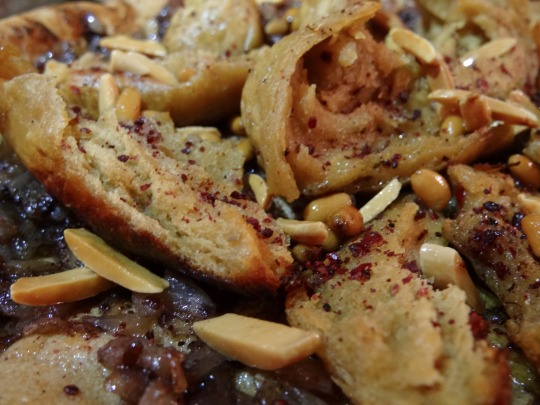
670 notes
·
View notes
Text
Fellow Travelers Timeline
(as comprehensive as i can make it. corrections/additions welcome)
1919-20 (?) - Hawk is born
based on tennis trophy which shows year 1936, and hawk's statement that he and kenny were on the tennis team in 11th grade (16/17 years old).

also date on the paperweight (1937) that hawk says kenny picked out on their senior trip. spring or fall though? if spring (usual for a senior trip, just before graduation), it would mean hawk graduated HS in 1937, b. 1919. (thanks, @lestatscunt!)
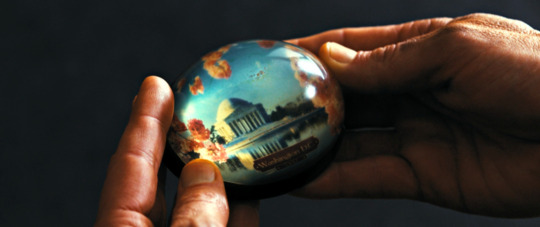
June 6, 1930 - Tim is born, on Staten Island, NY
birthdate/place shown on army application in ep 5
Gemini, with moon in Libra
>>> With a Gemini Sun Libra Moon, emotional equilibrium is hard for you to maintain in a world of constant flux and tension. Since you are not responsible for the woes and upsets of those around you, you should not feel so duty-bound to assuage their wounds or mediate every conflict that happens to come your way.
>>> your natural diplomacy, extraordinary perception and insight can all be applied creatively in such fields as politics, social work, and the mass media.
>>> your extreme open-mindedness would probably enable you to almost any life-style. You have a universal quality about you that transcends culture, religion, ideology, or any other barrier that divides mankind.
Fall 1937 - Spring 1941 - Hawk attends "Penn", presumably the University of Pennsylvania. (assuming hawk b. 1919)
(this is very very long, the rest is under the cut)
December 7, 1941 - bombing of Pearl Harbor, US enters WWII
??? - Hawk joins the army (along with Kenny), and is sent to Europe.
January 9 – August 15, 1945 - Battle of Luzon, where Kenny dies.
September 2, 1945 - Japan surrenders, US exits WWII
February, 1949 - Hawk starts working at the State Department
Hawk says in 1x04 (Dec 1953) that he's been working at the State Dept for "four years and ten months".
"I came out of the war with four assets: degree from Penn, a hero's war record, no particular political ideology, and a passing acquaintance with three languages. Throw in a talent for prevaricating and a taste for travel and fine clothes, you have the makings of a competent, mid-level Foreign Service bureaucrat."
Fall 1948 - Spring 1952 - Tim attends Fordham University, graduating with a degree in political science and history.
1951 - Hawk starts work for the Bureau of Congressional Relations
Tim mentions Hawk's been working there for two years during their meeting on the bench.
1952 - Tim works "the New York campaign" (presumably for Eisenhower).
1952/3? - Tim interns for three months at the Star, in the mailroom.
November 4, 1952 - Election Night, Eisenhower (R) wins the presidency. Tim/Hawk first meet and are instantly smitten. (ep 1)
February 16, 1953 to March 10, 1954 - McCarthy Hearings, part 1.
The first consisted of a series of hearings conducted by McCarthy, as the subcommittee’s chairman, throughout 1953 and early 1954 in which McCarthy alleged Communist influence within the press and the federal government, including the State Department, the U.S. Army, and the Government Printing Office.
March 5, 1953 - Stalin dies.
Late March, 1953 - Hawk/Tim second meeting
After Hawk meets Tim at the park bench, he attends a hearing where Marcus says Cohn has brought David Schine on, and then later at their lunch Senator Smith says, "McCarthy is sending Cohn and his sidekick to Europe..." This article, dated April 19, says that Cohn and Schine have been in Europe for two weeks.
Hawk mentions that it's near the end of the month, police need to make their quotas.

April 27, 1953 - Executive Order 10450 signed. Hawk goes to Tim's apartment and tells him about Kenny. (ep 1)
June 6, 1953 - Tim's 23rd birthday (Hawk 'misses' it because they weren't talking for 4 weeks. belated celebration in ep 3.)
June 15, 1953 (?) - date of the newspaper Tim is reading just before he goes to visit Hawk in ep 2, where Hawk makes him write the letter to Mary. I'm choosing to believe this is a mistake on the show's part, because this would mean that Hawk has already missed Tim's birthday.

June 19, 1953 - Julius and Ethel Rosenberg's execution. Hawk comforts Lucy about this at the end of ep 2. So, likely Hawk and Tim had their big fight very shortly before Tim's birthday, and weren't talking from end of May - end of June.
End of June, 1953 - at the end of ep 2, Tim says it's been 4 months since his last confession, making his last (proper) confession the end of Feb or beginning of March. (ie, before he meets Hawk again).
End of June or beginning of July, 1953 - weekend trip to Rehoboth Beach (ep 3)
November 1953 - G. David Schine drafted into the army (ep 3)
Christmas 1953 (ep 4)
March 16 to June 17, 1954 - Army-McCarthy Hearings (part 2) (ep 5)
The second phase involved the subcommittee's investigation of McCarthy’s attacks on the U.S. Army. Known as the “Army-McCarthy hearings,” they were broadcast on national television and they contributed to McCarthy’s declining national popularity. Five months later, on December 2, 1954, the Senate censured McCarthy.
June 6, 1954 - Tim's 24th birthday
June, 1954? - Tim/Hawk break up, Hawk proposes to Lucy (ep 5)
I believe this happens at the tail-end of the Army-McCarthy hearings, so before June 17th.
Fall, 1954 - Sen. Smith's funeral
based solely on fall foliage in this screenshot:
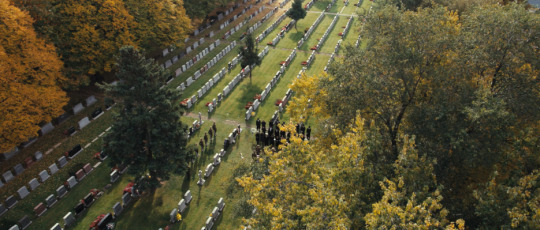
Late Nov / Early Dec, 1954 - Tim enlists in the army
based on army application: birthdate 6/6/30, age: 24 years, 6 months
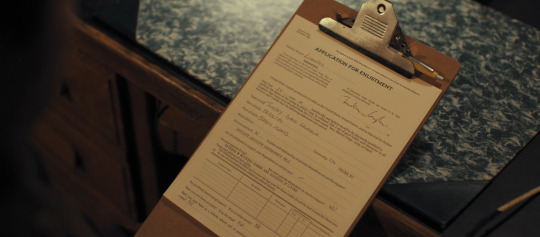
Late Nov / Early Dec, 1954 - Hawk/Tim last meeting in the tower
based on the radio program Tim is listening to, which says, "Chief Counsel Roy Cohn has resigned from the committee. And Senator McCarthy, his approval ratings plummeting, faces censure or even expulsion from the Senate."
Tim leaves for Fort Dix, for training, but is later stationed at Fort Polk, in Vernon Parish, LA. (thanks, @jesterlesbian!)

December 2, 1954 - the Senate censures McCarthy.
Summer or Fall 1956? - Tim's letter (that lucy burns) (ep 6)
Flashbacks, for context:
"Since he's giving up his apartment, Hawk insists on having a lair in the woods." // "I'm surprised that he finally agreed."
Lucy lets contractor go. // "Give me a baby."
Hawk is reading the Bristol Daily Courier, a paper located in Bristol, PA, a town in Bucks County, outside Philadelphia. I can't find any info on the one headline I can read though ("Heath Carlson breaks arws deadlock, locals proud"), so can't date this properly.
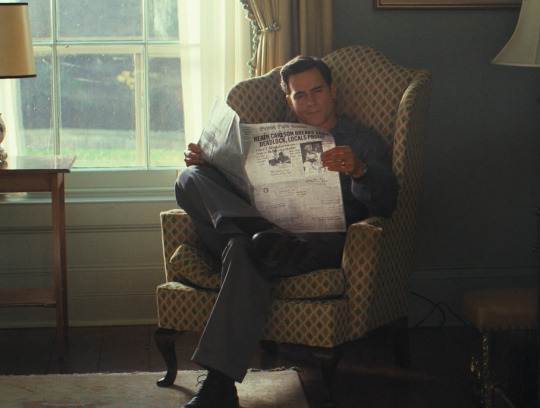
Lucy cleaning out Hawk's apartment, finds paperweight, sees Tim drop off letter.
"I went into the Army to get away from you. I thought time and distance would help. But it hasn't." If Tim sends the letter in summer 1956, it's been a year and a half since he enlisted.
Biggest question here: did lucy ask for a baby before or after she read Tim's letter??? the flashbacks don't answer this definitively.
October, 1956? - Lucy becomes pregnant with Jackson (see note under April 1957)
October 23 – November 4, 1956 - Hungarian Revolution of 1956
October 23, 1956 - April 30, 1957 - Hungarian Refugee Crisis
November 8, 1956 - Operation Safe Haven commences
President Eisenhower declared that 5,000 Hungarians would be awarded visa numbers remaining under the 1953 Refugee Relief Act
Spring 1957? - Tim sends telegram. It looks like 05-??-???? to me, which doesn't really make sense if McCarthy died on May 2nd, but it's hard to make out. or maybe telegrams used the date format dd-mm-yyyy.

April 1957? - Tim/Hawk first meeting, Lucy at least 5 (or 6? or 7?) months pregnant
You should feel your baby's first movements, called "quickening," between weeks 16 and 25 of your pregnancy. If this is your first pregnancy, you may not feel your baby move until closer to 25 weeks.
25 weeks ~= 6 months, and it still seems novel to her, so let's say she's approx. 6 months pregnant here.


May 2, 1957 - Joe McCarthy dies.
May 6, 1957 - McCarthy's funeral. Tim's first visit to Hawk's apartment (ep 8)
June 6, 1957 - Tim turns 27.
June or July, 1957 - Jackson born (based on dates above)

1958? - Kimberly is born. (estimated bc she looks the same age or older than Jackson, so assuming she's a year younger at most.)
August, 1965 - President Johnson signs a law making it a federal crime to destroy or mutilate [draft] cards.
October 15, 1965 -David Miller publicly burns his draft card, becoming the first person to be prosecuted under that law and a symbol of the growing movement against the war.
May 17, 1968 - the Catonsville Nine took 378 draft files from the draft board office in Catonsville, Maryland and burned them in the parking lot. (inspo for Tim & co. thanks @brokendrums!)
November 1968 - ep 6. Hawk is 48, Tim is 38, Jackson is 11.
based on this newspaper screenshot when Hawk is talking to Marcus on the phone about Tim

November 1968 - May 1970 (earliest) - Tim in prison. (he says in ep 7 he was in prison for a year and a half. this assumes he went to prison right away, but it could have been several months later if he was awaiting trial/sentencing.)
1970? - After prison, Tim moves to San Francisco and gets his counseling degree.
Mid-late 1970s - Tim earns his C-SWCM qualifications, requiring:
A Bachelor’s degree in social work from a graduate program accredited by the Council on Social Work Education
Documentation of at least three (3) years and 4,500 hours of paid, supervised, post-BSW professional experience in an organization or agency that provides case management services
Current state BSW-level license or an ASWB BSW-level exam passing score.
nb. because Tim already had his bachelors (from Fordham, majoring in history), I could see him entering a much-accelerated BSW program, transfering a lot of credits from his previous degree. That would give him maybe 2 more years of university, plus the required 3 years of post-BSW work = 5 years minimum before he earns that business card.
February 4, 1977 - Fleetwood Mac's album Rumours is released, including the 1970s Tim/Hawk anthem, Go Your Own Way
October, 1978 - Jackson dies

November 27, 1978 - Harvey Milk assassinated
May 22, 1979 - Harvey's 49th birthday (celebrated in ep 7)
1986 - ep 8
how long was Hawk in San Francisco? Timelines for the events below may be fudged in the show, bc I doubt he was there for 5 months.
March, 1986 - Roy Cohn's 60 Minutes interview, which the gang watches in ep 4.
April 15, 1986 - US bombs Libya. in the first episode you can hear reference to this on the radio, before Hawk leaves for San Francisco. (thanks @aliceinhorrorland93!)
July 27, 1986 - In California, Gov. George Deukmejian vetoes a bill that would have defined AIDS as a physical handicap calling for entitlement to protection under the state's civil rights laws.
August 2, 1986 - Roy Cohn dies (ep 8)
Late 1986? - the fundraising gala that Tim crashes, shortly after Cohn's death.
September 1986 - The State Legislature has passed another bill [in addition to the one vetoed on July 27]. Mr. Deukmejian, a Republican running for re-election, has indicated that he will probably veto the bill. (nb, this is likely the bill that Tim & co want to pressure the governor to sign).
October 11, 1987 - AIDS memorial quilt first displayed (ep 8)
--
this was a collaborative effort! many thanks to @ishipallthings for many of these details, as well as @startagainbuttercup , @alorchik, @itsalinh and others in the FT discord!
#fellow travelers#timeline#reference#i made this as comprehensive as i could but i would LOVE feedback/corrections#esp re: anything in 1956-1957 era#jackson's birth? and the date of that letter???
275 notes
·
View notes
Text
United States Patent and Trademark Office
0462795 – July 16, 1891 – Method Of Producing Rain-Fall
803180 – October 31, 1905 – Means for Producing High Potential Electrical Discharges
1103490 – August 6, 1913 – Rain-Maker
1225521 – September 4, 1915 – Protecting From Poisonous Gas In Warfare
1279823 – September 24, 1918 – Process and Apparatus for Causing Precipitation by Coalescence of Aqueous Particles Contained in the Atmosphere
1284982 – November 19, 1918 – Process and Apparatus for Procuring and Stimulating Rainfall
1338343 – April 27, 1920 – Process And Apparatus For The Production of Intense Artificial Clouds, Fogs, or Mists
1358084 – November 9, 1920 – Method of Producing Fog-Screens
1619183 – March 1, 1927 – Process of Producing Smoke Clouds From Moving Aircraft
1665267 – April 10, 1928 – Process of Producing Artificial Fogs
1892132 – December 27, 1932 – Atomizing Attachment For Airplane Engine Exhausts
1895765 – January 31, 1933 – Artificial Production of Fog
1928963 – October 3, 1933 – Electrical System And Method
1957075 – May 1, 1934 – Airplane Spray Equipment
1993316 – March 5, 1935 – Apparatus for and Method of Producing Oil Fog
2052626 – September 1, 1936 – Method of Dispelling Fog
2097581 – November 2, 1937 – Electric Stream Generator – Referenced in 3990987
2173756 – September 19, 1939 – Process of Producing Fog or Mist by Partial and Flameless Combustion
2352677 – July 4, 1944 – Artificial Fog Production
2476171 – July 18, 1945 – Smoke Screen Generator
2409201 – October 15, 1946 – Smoke Producing Mixture
2480967 – September 6, 1949 – Aerial Discharge Device
2527230 – October 24, 1950 – Method of Crystal Formation and Precipitation
2527231 – October 24, 1950 – Method of Generating Silver Iodide Smoke
2550324 – April 24, 1951 – Process For Controlling Weather
2582678 – June 15, 1952 – Material Disseminating Apparatus For Airplanes
2611992 – September 30, 1952 – Engine Exhaust Operated Fluent Material Distributor
2614083 – October 14, 1952 – Metal Chloride Screening Smoke Mixture
2633455 – March 31, 1953 – Smoke Generator
2688069 – August 31, 1954 – Steam Generator – Referenced in 3990987
2721495 – October 25, 1955 – Method And Apparatus For Detecting Minute Crystal Forming Particles Suspended in a Gaseous Atmosphere
2730402 – January 10, 1956 – Controllable Dispersal Device
2903188 – April 2, 1956 – Control of Tropical Cyclone Formation
2756097 – July 24, 1956 – Process for Weather Control
2801322 – July 30, 1957 – Decomposition Chamber for Monopropellant Fuel – Referenced in 3990987
2835530 – May 20, 1958 – Process for the Condensation of Atmospheric Humidity and Dissolution of Fog
2871344 – January 27, 1959 – Long Distance Communication System
2881335 – April 7, 1959 – Generation of Electrical Fields
2908442 – October 13, 1959 – Method For Dispersing Natural Atmospheric Fogs And Clouds
2962450 – November 29, 1960 – Fog Dispelling Composition
2963975 – December 13, 1960 – Cloud Seeding Carbon Dioxide Bullet
3019989 – February 6, 1962 – Atmospheric Space Charge Modification
2986360 – May 30, 1962 – Aerial Insecticide Dusting Device
3046168 – July 24, 1962 – Chemically Produced Colored Smokes
3056556 – October 2, 1962 – Method of Artificially Influencing the Weather
3126155 – March 24, 1964 – Silver Iodide Cloud Seeding Generator
3127107 – March 31, 1964 – Generation of Ice-Nucleating Crystals
3131131 – April 28, 1964 – Electrostatic Mixing in Microbial Conversions
3140207 – July 7, 1964 – Pyrotechnic Composition
3174150 – March 16, 1965 – Self-Focusing Antenna System
3234357 – February 8, 1966 – Electrically Heated Smoke Producing Device
3274035 – September 20, 1966 – Metallic Composition For Production of Hydroscopic Smoke
3284005 – November 8,1966 – Weather Control by Artificial Means
3300721 – January 24, 1967 – Means For Communication Through a Layer of Ionized Gases
3313487 – April 11, 1967 – Cloud Seeding Apparatus
3338476 – August 29, 1967 – Heating Device For Use With Aerosol Containers
175 notes
·
View notes
Text
Pls Help
It’s been a very rough week, and I am in need of help raising some money. I have made a previous post on the matter, but it was lengthy, poorly worded, and I made it while panicking. It’s been a few days, so I had time to calm down and collect my thoughts and focus on what I need now.
Long story short, I just spent my entire savings on saving our house, helping my mom catch up on bills and rent. We’re still behind, but we’re in a much better position than we were before. Earlier in the week my mom’s car broke down, and it’s kaput. She needs a new car. I’ve been driving her to work, but my car was borrowed from my dad, who, turns out, is also at risk of losing his house. Literally the day after I spent all of my savings, he called me and said he wants my car back for resale, and after explaining my situation to him, he has given me a few more months to save enough money to get a new car. So the one car my mom and I have between each other is also going to be taken away soon. There is no possible way for us to walk to work, as our jobs are out of town, and we live in the USA where public transit is nonexistent.
So here’s what I need:
My goal is to raise $5000 USD by October 1st. If the goal isn’t met, I could extend that to November 1st. Any later though, I may not be able to extend any more. This money will go to getting a new car. I work part-time and make little more than $1000 a month, and I need to pay bills on the side, so I would be heavily relying on you guys to help me. I will be raising $400 a month myself to add to savings, the rest going to bills and important things like food. Every dollar that is donated through the links below will be going to my car savings.
Cash App: $SRockford96
Paypal: [email protected]
Ko-fi: https://ko-fi.com/andraws
Patreon: https://www.patreon.com/forestinchaostcg (on hiatus)
$1936/$5000 raised as of 9/30/2023
881 notes
·
View notes
Text

Saucy Movie Tales - November 1936
34 notes
·
View notes
Photo
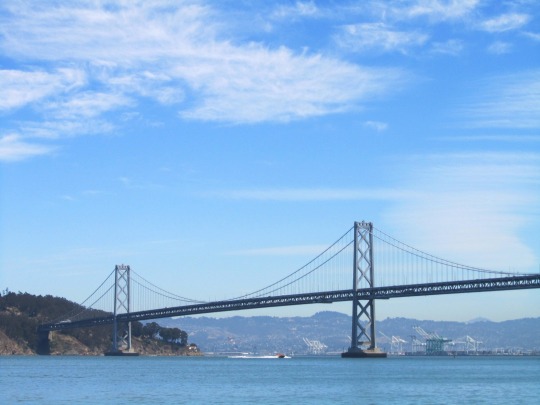
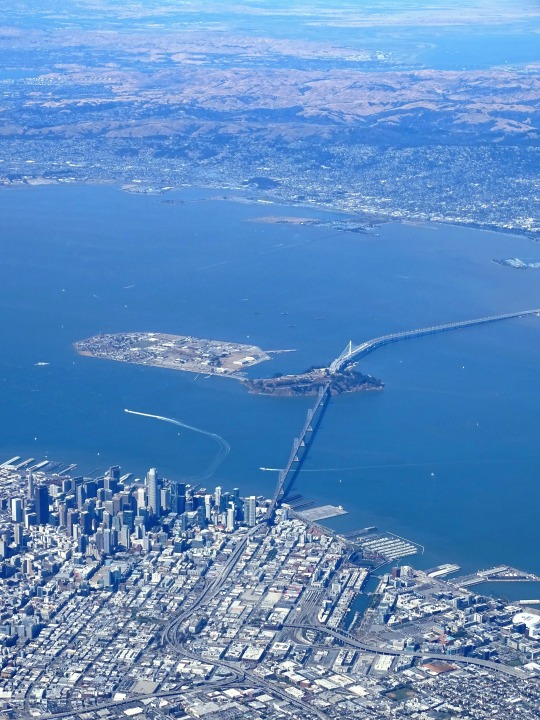








The San Francisco–Oakland Bay Bridge opened to traffic on November 12, 1936.
#San Francisco–Oakland Bay Bridge#opened#12 November 1936#California#anniversary#US history#Pacific Ocean#Charles H. Purcell#cityscape#USA#San Francisco#Oakland#original photography#tourist attraction#landmark#2018#summer 2008#2012#on board#plane#West Coast#vacation#travel
19 notes
·
View notes
Text


Spanish militiamen fighting fascist forces in the Casa de Campo area, Madrid. November 1936
149 notes
·
View notes